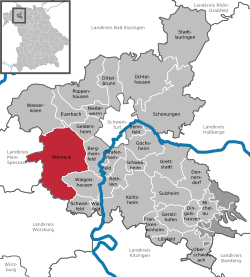Werneck
| Werneck | ||
|---|---|---|
|
||
| Coordinates: 49°59′N 10°6′E / 49.983°N 10.100°ECoordinates: 49°59′N 10°6′E / 49.983°N 10.100°E | ||
| Country | Germany | |
| State | Bavaria | |
| Admin. region | Unterfranken | |
| District | Schweinfurt | |
| Government | ||
| • Mayor | Edeltraud Baumgartl (CSU) | |
| Area | ||
| • Total | 73.56 km2 (28.40 sq mi) | |
| Elevation | 222 m (728 ft) | |
| Population (2015-12-31) | ||
| • Total | 10,206 | |
| • Density | 140/km2 (360/sq mi) | |
| Time zone | CET/CEST (UTC+1/+2) | |
| Postal codes | 97440 | |
| Dialling codes | 09722 | |
| Vehicle registration | SW | |
| Website | www.werneck.de | |
Werneck is a market town in the district of Schweinfurt in Lower Franconia, Bavaria, Germany. It has a population of around 10,000 and is best known for its Baroque palace, Schloss Werneck.
Werneck lies in the Lower Franconia region of Bavaria, approximately 12 km from Schweinfurt and 25 km from Würzburg. It is located on a bend in the Wern, a tributary of the Main, on the edge of the plateau above the river. Its highest point is at 337.20 m of elevation, its lowest at 212.50 m. The total area of the municipality is 73.65 km², of which approximately 9 km² are wooded.
Werneck has the following Ortsteile:
The first written record of Werneck is dated 10 August 1223, as a fief granted by Bodo of Ravensburg, confirmed by the Pope on 9 April 1223. Between 1224 and 1250, possession of the fief was shared between first the Teutonic Knights and later Conrad of Reichenberg and Conrad of Schmiedefeld, until it finally passed to the Bishopric of Würzburg. A fort located there was sacked in the Peasants' War in 1525 and then seized and burnt down by Albert Alcibiades, Margrave of Brandenburg-Kulmbach in 1553. It was rebuilt in 1601 under Prince-Bishop Julius Echter von Mespelbrunn, but was again destroyed by fire in 1723 and merely patched up in 1724.
The current baroque palace, Schloss Werneck, designed by Balthasar Neumann, was built in 1733–45 by Prince Bishop Friedrich Karl von Schönborn. For half a century it was, with Veitshöchheim, a summer residence of the Bishops of Würzburg. On 28 November 1802, the last Prince-Bishop of Würzburg, Georg Karl von Fechenbach, released his vassals there from their oaths of service and recommended them to the new regional overlord, Maximilian, Prince-Elector of Bavaria.
...
Wikipedia



